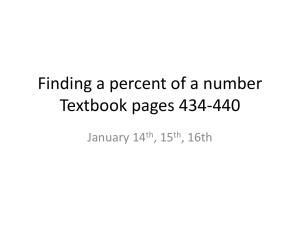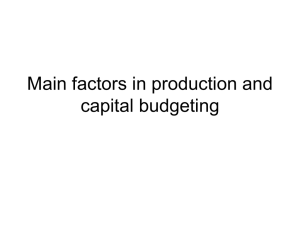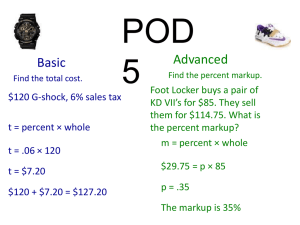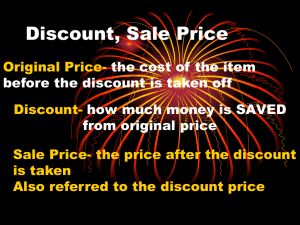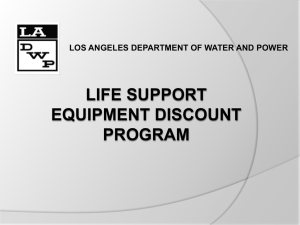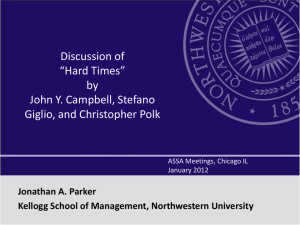FixedCost
advertisement
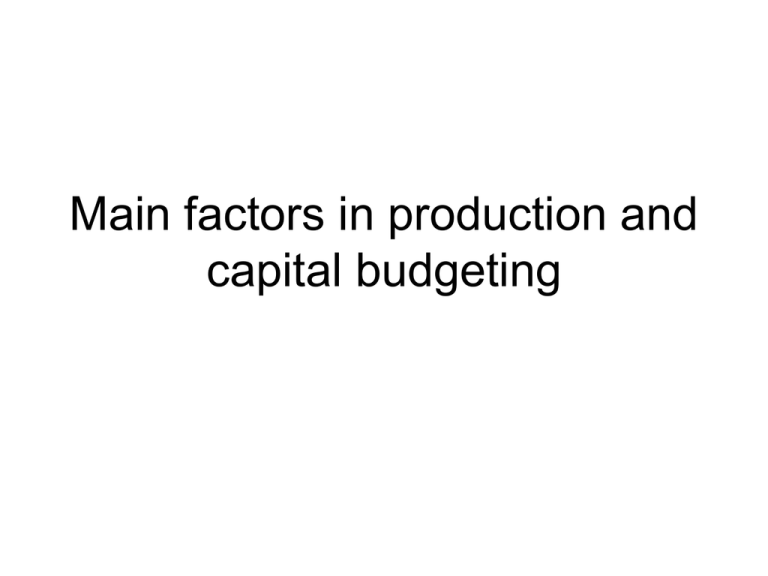
Main factors in production and capital budgeting • • • • • • Fixed cost Duration of production Discount rate Uncertainty Market size Other factors? Fixed cost • The necessity of fixed cost – The ability to obtain resources and generate revenues require initial fixed investment • Examples – Parental investment – Education – Project investment • How much to invest in fixed costs? Low fixed cost economy • • • • • Fixed cost: 1 Variable cost: 80% of output Value per unit output: 1 Size of output: 10 Profit: – (1-0.8)*10-1= 1 High fixed cost economy • • • • • Fixed cost: 100 Variable cost: 50% of output Value per unit output: 10 Size of output: 30 Profit: – 10*(1-0.5)*30-100 = 50 Upside of high fixed cost systems • • • • low variable costs Capable of produce high value products Large production capacity High profit when output level is high Downside of high fixed cost systems • • • • • • Large initial investment Take long time to break even Require large market size Vulnerable to downside risk large amount resource support Complex social structures and social policies Duration of production • A project lasts for some time. How to choose duration of production? • Benefit of long duration – Initial investment can be utilized for a long time • Cost of long duration – Increase the maintenance cost and the variable cost in production. Relation between duration of production and fixed cost • In general, higher fixed cost projects last longer • Examples – Elephants live longer than mice, which live longer than bacteria – Large companies last longer than small companies – Professionals, who take a lot of efforts to get qualifications, switch professions less often than nonprofessionals – Other examples? Discounting • Cash flows at different points of time need to be measured with discounting. • The determination of discount rates is the most difficult problem in finance. • We will spend most time on this problem in this course. Fixed cost and discount rate A company has a choice to select one of the two projects. The first project requires an initial spending of 10 million dollars. The project will generate 2 million dollar profit each year. The second project requires an initial spending of 20 million dollars. The project will generate 3.5 million dollar profit each year. Both projects last for 10 years. If the discount rate is 5% per year, which project you will choose? If the discount rate is 12% per year, which project you will choose? The criterion of selection is NPV of a project. Answers • 12% discount rate – Project 1: 1.3 – Project 2: -0.22 • 5% discount rate – Project 1: 5.44 – Project 2: 7.02 Fixed cost and uncertainty • Question: – Is lower discount rate always better for the economy? • Someone proposes a project to you. He claims that the profit from the project will increase 10% per year for the next hundred years. • You might think his projection should be heavily discounted. That’s right. • Uncertainty is often reflected in discount rate. • But why central banks seem to be able to adjust discount rate freely? A rising tide lifts all boats • In a rising economy, even optimistic projections are often realized. The last several hundred years are a rising tide. In such an environment, high fixed cost, low discount rate policies are generally winners. However, many signs indicates that we are at the peak of the tide. We will leave the systematic discussion to the section on interest rate policies. Fixed cost and market size • • • • • Suppose you are opening a restaurant and there are two potential sites: The central site costs $10 000/ month and has a marginal cost of 40%. The remote site costs $4 000/ month and has a marginal cost of 60%. What is the potential profit of each site if you generate a revenue of $20 000? $40 000? What site would you choose under each circumstance? Fixed cost and duration of project A company has a choice to select one of the two projects. The first project requires an initial spending of 10 million dollars. The project will generate 3 million dollar profit each year. The second project requires an initial spending of 20 million dollars. The project will generate 5 million dollar profit each year. The discount rate is 5% per year. If two projects last for 5 years, which project you will choose? If two projects last for 10 years, which project you will choose? The criterion of selection is NPV of a project. Answers • 5 years – Project 1: 2.99 – Project 2: 1.65 • 10 years – Project 1: 17.99 – Project 2: 26.65 Other factors? • Liquidity, fixed cost and discount rate • If you can not sell a project easily and have to operate the project yourself during its entire life, what kinds of fixed cost and discount rate you will choose? • If you can sell a project easily, what kinds of fixed cost and discount rate you will choose? • MBS and financial crisis. • Other factors? Financing of Fixed cost • Some high fixed cost projects are self financed • However, many projects require billions of dollar initial capital – Oil sand projects – Mining projects – Pipelines • External financing Methods of external financing • Debt financing and equity financing – Debt financing: fixed interest payment, higher fixed cost, maintaining more control, more risky – Equity financing: dividend distribution more flexible, lower fixed cost, maintaining less control, less risky • • Debt financing – Public debt: Issuing cost as fixed cost, generally lower interest payment, more information release – Bank financing: No issuing cost, generally higher interest payment, less information release • Tradeoffs between bank financing and public debt – If the size of debt issuing is large, which method you would prefer? Selective advantages of different pathogens • Virus, bacteria and protists and common pathogens with different sizes. • In human organizations of different wealth levels, types of diseases are often different. • In wealthy social organizations, diseases are often caused by viruses while in poor social organizations, serious diseases are often caused by protists. Why the difference? • Protists are larger and require more investments. In environments where pathogens are vigorously attacked and couldn’t survive for a long time, large investments do not payoff. In wealthy social systems, people are well nourished and medical care is well funded, large pathogens, such as protists, do not perform well; small pathogens, such as virus, live a very short time and can mutate very fast, are more successful. Aids is caused by viruses, RNA coded viruses which mutate very fast. • In poor social environments, where people are poorly nourished and their immune systems are weak, large pathogens have a better chance to recoup their investments. Hence diseases such as malaria, which is caused by protists, are common in poor countries but not in rich countries. Nuclear weapons and terrorists • Since the birth of nuclear weapons, there has been constant worry for terrorists to acquire nuclear weapons. But it has not happened so far. Why? • To acquire nuclear weapons would need high level of investment both financially and organizationally. This makes terrorist groups easy target. Therefore, terrorist groups prefer low cost, low profile activities.


